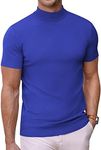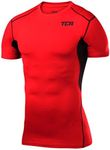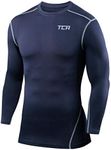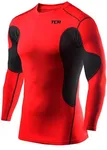Buying Guide for the Best Cold Weather Base Layer
Choosing the right cold-weather base layer is crucial for staying warm and comfortable during outdoor activities in chilly conditions. A base layer is the first layer of clothing worn next to your skin, and it plays a vital role in moisture management and insulation. The right base layer will help regulate your body temperature, wick away sweat, and keep you dry. Here are some key specifications to consider when selecting a cold-weather base layer and how to choose the best one for your needs.MaterialThe material of a base layer is important because it affects how well the layer can wick moisture, retain heat, and feel against your skin. Common materials include synthetic fabrics like polyester and natural fibers like merino wool. Synthetic fabrics are great for high-intensity activities as they wick moisture quickly and dry fast. Merino wool is excellent for its warmth, odor resistance, and comfort, making it ideal for low to moderate activities. Choose a material based on your activity level and personal preference for comfort and warmth.
WeightBase layers come in different weights: lightweight, midweight, and heavyweight. Lightweight base layers are best for high-intensity activities where you generate a lot of body heat, as they provide good moisture-wicking and breathability. Midweight base layers offer a balance of warmth and moisture management, suitable for moderate activities in cold weather. Heavyweight base layers provide maximum warmth and are ideal for low-intensity activities or extremely cold conditions. Select the weight based on the intensity of your activity and the expected weather conditions.
FitThe fit of a base layer is crucial for its performance. A snug fit ensures that the fabric can effectively wick moisture away from your skin and trap body heat. However, it should not be so tight that it restricts movement or causes discomfort. Look for a base layer that fits close to your body without being too tight. Consider your activity level and personal comfort when choosing the fit, as a proper fit enhances the base layer's ability to keep you warm and dry.
SeamsSeams can affect the comfort and durability of a base layer. Flatlock seams are designed to lie flat against your skin, reducing the risk of chafing and irritation, which is especially important during prolonged activities. Additionally, fewer seams generally mean less potential for discomfort. When choosing a base layer, look for flatlock seams or seamless construction to ensure maximum comfort, especially if you plan to wear the base layer for extended periods.
Moisture-WickingMoisture-wicking is the ability of the fabric to draw sweat away from your skin and disperse it across the surface for quick evaporation. This is important because it helps keep you dry and prevents you from getting cold due to dampness. Synthetic materials typically excel at moisture-wicking, while merino wool also offers good moisture management with the added benefit of natural odor resistance. Choose a base layer with good moisture-wicking properties to stay dry and comfortable during your activities.
Odor ResistanceOdor resistance is a feature that helps keep your base layer smelling fresh, even after prolonged use. This is particularly important for multi-day activities or when you have limited opportunities to wash your gear. Merino wool naturally resists odors, while some synthetic fabrics are treated with antimicrobial finishes to achieve similar results. If you plan to wear your base layer for extended periods without washing, consider one with good odor resistance to maintain comfort and hygiene.






















